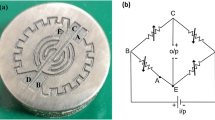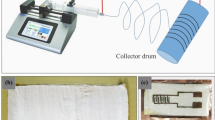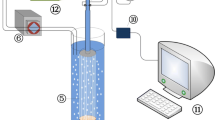Abstract
The safe operation of power transformer is vital to the reliability of modern power network. The bushing is a key component of transformer that serves to connect the transformer windings to the transmission lines. Due to its intricate structure and severe operating conditions, the bushing is among the most frequent cause of transformer failure. Therefore, it is essential to monitor the condition of transformer bushing for maintaining the safe and stable operation of grid. In this paper, we propose a graphene piezoresistive pressure sensor based on handkerchief paper (GHPPS) to monitor the internal pressure of transformer bushing. The GHPPS possesses a highly porous structure and a fibrous tissue, and exhibits a superb sensitivity to the variations of bushing internal pressure. Moreover, we compared the sensitivity and conductivity of the sensors with different paper layers. The GHPPS with 8 layers owns the highest sensitivity (15.6 kPa−1), the smallest response time (60 ms) and recovery time (75 ms), and the best stability. In addition, a hierarchical alarm device is used to test the monitoring capability of GHPPS at different pressure levels. The results prove that the GHPPS is a promising tool for monitoring bushing conditions.








Similar content being viewed by others
References
Baravati PR, Moazzami M, Hassan Hosseini SM, Mirzaei HR, Fani B (2022) Achieving the exact equivalent circuit of a large-scale transformer winding using an improved detailed model for partial discharge study. Int J Electr Power Energy Syst 134:107451
Nascimento D, Refaat SS, Loschi H, Iano Y, Chuma E, El-Sayed W, Madi A (2021) Current sensor optimization based on simulated transfer function under partial discharge pulses. Sens Actuators, A 329:112825
Rostaminia R, Saniei M, Vakilian M, Mortazavi SS (2016) Evaluation of transformer core contribution to partial discharge electromagnetic waves propagation. Int J Electr Power Energy Syst 83:40–48
Ma S, Yang D, Liang B, Jin Y (2019) Impact of metal particle size on partial discharge characteristics of moving metal particles in transformer oil. Chem Phys Lett 731:136577
Taha IBM, Dessouky SS, Ghaly RNR, Ghoneim SSM (2020) Enhanced partial discharge location determination for transformer insulating oils considering allocations and uncertainties of acoustic measurements. Alex Eng J 59:4759–4769
Seifi S, Werle P, Akmal AAS, Mohseni H, Borsi H (2021) A feasibility study on estimating induced charge of partial discharges in transformer windings adjacent to its origin. Int J Electr Power Energy Syst 129:106899
Si W, Fu C, Yuan P (2019) An integrated sensor with AE and UHF methods for partial discharges detection in transformers based on oil valve. IEEE Sens Lett 3:1–3
Xue N et al (2019) The location of partial discharge sources inside power transformers based on TDOA database with UHF sensors. IEEE Access 7:146732–146744
Zhang Q, Li C, Zheng S, Yin H, Kan Y, Xiong J (2016) Remote detecting and locating partial discharge in bushings by using wideband RF antenna array. IEEE Trans Dielectr Electr Insul 23:3575–3583
Kondalkar VV, Ryu G, Lee Y, Lee K (2019) Development of highly sensitive and stable humidity sensor for real-time monitoring of dissolved moisture in transformer-insulating oil. Sens Actuators B: Chem 286:377–385
Villarroel R, de Burgos BG, García DF (2021) Moisture dynamics in natural-ester filled transformers. Int J Electr Power Energy Syst 124:106172
Marulanda V, Bolaños G (2010) Supercritical water oxidation of a heavily PCB-contaminated mineral transformer oil: laboratory-scale data and economic assessment. J Supercrit Fluids 54:258–265
Bustamante S, Manana M, Arroyo A, Castro P, Laso A, Martinez R (2019) Dissolved gas analysis equipment for online monitoring of transformer oil: a review. Sensors 19:4057
MacAlpine M, Zhiqiang Z, Demokan MS (2002) Development of a fibre-optic sensor for partial discharges in oil-filled power transformers. Electric Power Syst Res 63:27–36
Castro B, Clerice G, Ramos C, Andreoli A, Baptista F, Campos F, Ulson J (2016) Partial discharge monitoring in power transformers using low-cost piezoelectric sensors. Sensors 16:1266
Raghavan A et al (2021) Low-cost embedded optical sensing systems for distribution transformer monitoring. IEEE Trans Power Deliv 36:1007–1014
Liu Y, Li L, Zhao L et al (2017) Research on a new fiber-optic axial pressure sensor of transformer winding based on fiber Bragg grating. Photonic Sens 7:365–371
Sun C, Ohodnicki PR, Stewart EM (2017) Chemical sensing strategies for real-time monitoring of transformer oil: a review. IEEE Sens J 17:5786–5806
Jiang P, Zhang Z, Dong Z, Yongye Wu, Xiao R, Deng J, Pan Z (2021) Research on distribution characteristics of vibration signals of ±500 kV HVDC converter transformer winding based on load test. Int J Electr Power Energy Syst 132:107200
Kim J-S, So Y, Lee S, Pang C, Park W, Chun S (2021) Uniform pressure responses for nanomaterials-based biological on-skin flexible pressure sensor array. Carbon 181:169–176
Long Y, He P, Xu R, Hayasaka T, Shao Z, Zhong J, Lin L (2020) Molybdenum-carbide-graphene composites for paper-based strain and acoustic pressure sensors. Carbon 157:594–601
Yang G, Tian M-Z, Huang P, Ya-Fei Fu, Li Y-Q, Ya-Qin Fu, Wang X-Q, Li Y, Ning Hu, Shao-Yun Fu (2021) Flexible pressure sensor with a tunable pressure-detecting range for various human motions. Carbon 173:736–743
Uwayid R, Seraphim NM, Guyes EN, Eisenberg D, Suss ME (2021) Characterizing and mitigating the degradation of oxidized cathodes during capacitive deionization cycling. Carbon 173:1105–1114
Xiong Y, Shen Y, Tian L, Yougen Hu, Zhu P, Sun R, Wong C-P (2020) A flexible, ultra-highly sensitive and stable capacitive pressure sensor with convex microarrays for motion and health monitoring. Nano Energy 70:104436
Chang YC, Yen CC, Tsai HC, Chen TC, Yang CM, Chen CH, Woon WY (2020) Characteristics of graphene grown through low power capacitive coupled radio frequency plasma enhanced chemical vapor deposition. Carbon 159:570–578
Hosseini ES, Manjakkal L, Shakthivel D, Dahiya R (2020) Glycine−chitosan-based flexible biodegradable piezoelectric pressure sensor. ACS Appl Mater Interfaces 12:9008–9016
Xi X, Chung DDL (2019) Capacitance-based self-sensing of flaws and stress in carbon-carbon composites, with reports of the electric permittivity, piezoelectricity and piezoresistivity. Carbon 146:447–461
Vivekananthan V, Chandrasekhar A, Alluri NR, Purusothaman Y, Kim SJ (2020) A highly reliable, impervious and sustainable triboelectric nanogenerator as a zero-power consuming active pressure sensor. Nanoscale Adv 2:746–754
Xia X, Chen J, Liu G, Javed MS, Wang X, Hu C (2017) Aligning graphene sheets in PDMS for improving output performance of triboelectric nanogenerator. Carbon 111:569–576
Jingjing Wu, Li H, Lai X, Chen Z, Zeng X (2020) Conductive and superhydrophobic F-rGO@CNTs/chitosan aerogel for piezoresistive pressure sensor. Chem Eng J 386:123998
Qi K, Zhou Y, Kangkang Ou, Dai Y, You X, Wang H, He J, Qin X, Wang R (2020) Weavable and stretchable piezoresistive carbon nanotubes-embedded nanofiber sensing yarns for highly sensitive and multimodal wearable textile sensor. Carbon 170:464–476
Kim N-I, Chang Y-L, Chen J, Barbee T, Wang W, Kim J-Y, Kwon M-K, Shervin S, Moradnia M, Pouladi S, Khatiwada D, Selvamanickam V, Ryou J-H (2020) Piezoelectric pressure sensor based on flexible gallium nitride thin film for harsh-environment and high-temperature applications. Sens Actuators, A 305:111940
Yang Ye, Pan H, Xie G, Jiang Y, Chen C, Yuanjie Su, Wang Y, Tai H (2020) Flexible piezoelectric pressure sensor based on polydopamine-modified BaTiO3/PVDF composite film for human motion monitoring. Sens Actuators, A 301:111789
Wang S, Shao H-Q, Liu Y, Tang C-Y, Zhao X, Ke K, Bao R-Y, Yang M-B, Yang W (2021) Boosting piezoelectric response of PVDF-TrFE via MXene for self-powered linear pressure sensor. Compos Sci Technol 202:108600
Chen JM, Zhang J, Hu JL, Luo NQ, Sun FX, Venkatesan H, Zhao N, Zhang YT (2021) Ultrafast-response/recovery flexible piezoresistive sensors with dna-like double helix yarns for epidermal pulse monitoring. Adv Mater 34:2104313
Silvestri A, Criado A, Poletti F, Wang F, Fanjul-Bolado P, González-García MB, García-Astrain C, Liz-Marzán LM, Feng X, Zanardi C, Prato M (2021) Bioresponsive, electroactive, and inkjet-printable graphene-based inks. Adv Funct Mater 32:2105028
Shan J, Wang S, Zhou F, Hu J, Liu Q, Lin S, Zhang Y, Liu Z (2021) Designing new-generation piezoelectric transducers by embedding superior graphene-based thermal regulators. Adv Mater 33:2103141
Qiao X, Niu C, Liao D, Chen Z, Sun L, Xu Y (2021) A self-growth strategy for simultaneous modulation of interlayer distance and lyophilicity of graphene layers toward ultrahigh potassium storage performance. Adv Funct Mater 31:2105145
Tingting Yu, Zhang D, Yali Wu, Guo S, Lei F, Li Y, Yang J (2021) Graphene foam pressure sensor based on fractal electrode with high sensitivity and wide linear range. Carbon 182:497–505
Tran MT, Tung TT, Sachan A, Losic D, Castro M, Feller JF (2020) 3D sprayed polyurethane functionalized graphene / carbon nanotubes hybrid architectures to enhance the piezo-resistive response of quantum resistive pressure sensors. Carbon 168:564–579
Yang J, Ye Y, Li X, Lü X, Chen R (2018) Flexible, conductive, and highly pressure-sensitive graphene-polyimide foam for pressure sensor application. Compos Sci Technol 164:187–194
Kim SJ, Mondal S, Min BK, Choi CG (2018) Highly sensitive and flexible strain-pressure sensors with cracked paddy-shaped MoS2/graphene foam/ecoflex hybrid nanostructures. ACS Appl Mater Interfaces 10:36377–36384
Brodie BC (1859) On the atomic weight of graphite. Philos Trans R Soc Lond 14:249–259
Chen Ji, Li Y, Huang L, Li C, Shi G (2015) High-yield preparation of graphene oxide from small graphite flakes via an improved Hummers method with a simple purification process. Carbon 81:826–834
Staudenmaier L (1898) Verfahren zur Darstellung der Graphitsa¨ure. Ber Dtsch Chem Ges 31:1481–1487
Poh HL, Šaněk F, Ambrosi A, Zhao G, Sofer Z, Pumera M (2012) Graphenes prepared by Staudenmaier Hofmann and Hummers methods with consequent thermal exfoliation exhibit very different electrochemical properties. Nanoscale 4:3515–3522
Lin J, Li P, Liu Y, Wang Z, Wang Ya, Ming X, Gao C, Zhen Xu (2021) The origin of the sheet size predicament in graphene macroscopic papers. ACS Nano 15:4824–4832
Alkhouzaam A, Qiblawey H, Khraisheh M, Atieh M, Al-Ghouti M (2020) Synthesis of graphene oxides particle of high oxidation degree using a modified Hummers method. Ceram Int 46:23997–24007
Li X, Wang Y, Chang J, Sun H, He H, Qian C, Kheirabad AK, An QF, Wang N, Zhang M, Yuan J (2021) Mix-then-on-demand-complex in situ cascade anionization and complexation of graphene oxide for high-performance nanofiltration membranes. ACS Nano 15:4440–4449
Hou Y, Lv S, Liu L, Liu X (2020) High-quality preparation of graphene oxide via the Hummers’ method: understanding the roles of the intercalator, oxidant, and graphite particle size. Ceram Int 46:2392–2402
Yang J, Tang D, Ao J, Ghosh T, Neumann TV, Zhang D, Piskarev Y, Yu T, Truong VK, Xie K, Lai Y-C, Li Y, Dickey MD (2020) Ultrasoft liquid metal elastomer foams with positive and negative piezopermittivity for tactile sensing. Adv Funct Mater 30:2002611
Wang Y, Mao H, Wang Y, Zhu P, Liu C, Deng Y (2020) 3D geometrically structured PANI/CNT-decorated polydimethylsiloxane active pressure and temperature dual-parameter sensors for man–machine interaction applications. J Mater Chem A 8:15167–15176
Tang Z, Jia S, Zhou C, Li Bo (2020) 3D printing of highly sensitive and large-measurement-range flexible pressure sensors with a positive piezoresistive effect. ACS Appl Mater Interfaces 12:28669–28680
Acknowledgements
This work is supported by the funding of the Natural Science Foundation of China (52177129).
Author information
Authors and Affiliations
Corresponding author
Additional information
Publisher's Note
Springer Nature remains neutral with regard to jurisdictional claims in published maps and institutional affiliations.
Rights and permissions
Springer Nature or its licensor (e.g. a society or other partner) holds exclusive rights to this article under a publishing agreement with the author(s) or other rightsholder(s); author self-archiving of the accepted manuscript version of this article is solely governed by the terms of such publishing agreement and applicable law.
About this article
Cite this article
Jiang, T., Zhang, T., Li, Y. et al. Highly-Efficient Graphene Pressure Sensor with Hierarchical Alarm for Detecting the Transient Internal Pressure of Transformer Bushing. J. Electr. Eng. Technol. 18, 3071–3082 (2023). https://doi.org/10.1007/s42835-022-01359-x
Received:
Revised:
Accepted:
Published:
Issue Date:
DOI: https://doi.org/10.1007/s42835-022-01359-x




